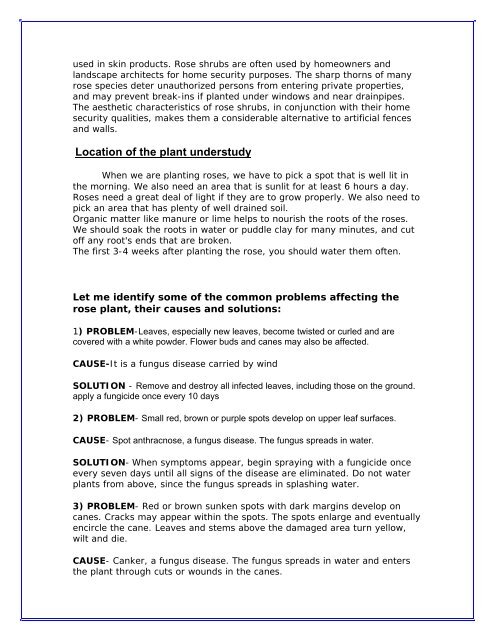A RESEARCH ON â¦. THE PROPAGATION OF ROSE PLANT â¦. IN ...
A RESEARCH ON â¦. THE PROPAGATION OF ROSE PLANT â¦. IN ...
A RESEARCH ON â¦. THE PROPAGATION OF ROSE PLANT â¦. IN ...
Create successful ePaper yourself
Turn your PDF publications into a flip-book with our unique Google optimized e-Paper software.
used in skin products. Rose shrubs are often used by homeowners and<br />
landscape architects for home security purposes. The sharp thorns of many<br />
rose species deter unauthorized persons from entering private properties,<br />
and may prevent break-ins if planted under windows and near drainpipes.<br />
The aesthetic characteristics of rose shrubs, in conjunction with their home<br />
security qualities, makes them a considerable alternative to artificial fences<br />
and walls.<br />
Location of the plant understudy<br />
When we are planting roses, we have to pick a spot that is well lit in<br />
the morning. We also need an area that is sunlit for at least 6 hours a day.<br />
Roses need a great deal of light if they are to grow properly. We also need to<br />
pick an area that has plenty of well drained soil.<br />
Organic matter like manure or lime helps to nourish the roots of the roses.<br />
We should soak the roots in water or puddle clay for many minutes, and cut<br />
off any root's ends that are broken.<br />
The first 3-4 weeks after planting the rose, you should water them often.<br />
Let me identify some of the common problems affecting the<br />
rose plant, their causes and solutions:<br />
1) PROBLEM-Leaves, especially new leaves, become twisted or curled and are<br />
covered with a white powder. Flower buds and canes may also be affected.<br />
CAUSE-It is a fungus disease carried by wind<br />
SOLUTI<strong>ON</strong> - Remove and destroy all infected leaves, including those on the ground.<br />
apply a fungicide once every 10 days<br />
2) PROBLEM- Small red, brown or purple spots develop on upper leaf surfaces.<br />
CAUSE- Spot anthracnose, a fungus disease. The fungus spreads in water.<br />
SOLUTI<strong>ON</strong>- When symptoms appear, begin spraying with a fungicide once<br />
every seven days until all signs of the disease are eliminated. Do not water<br />
plants from above, since the fungus spreads in splashing water.<br />
3) PROBLEM- Red or brown sunken spots with dark margins develop on<br />
canes. Cracks may appear within the spots. The spots enlarge and eventually<br />
encircle the cane. Leaves and stems above the damaged area turn yellow,<br />
wilt and die.<br />
CAUSE- Canker, a fungus disease. The fungus spreads in water and enters<br />
the plant through cuts or wounds in the canes.







